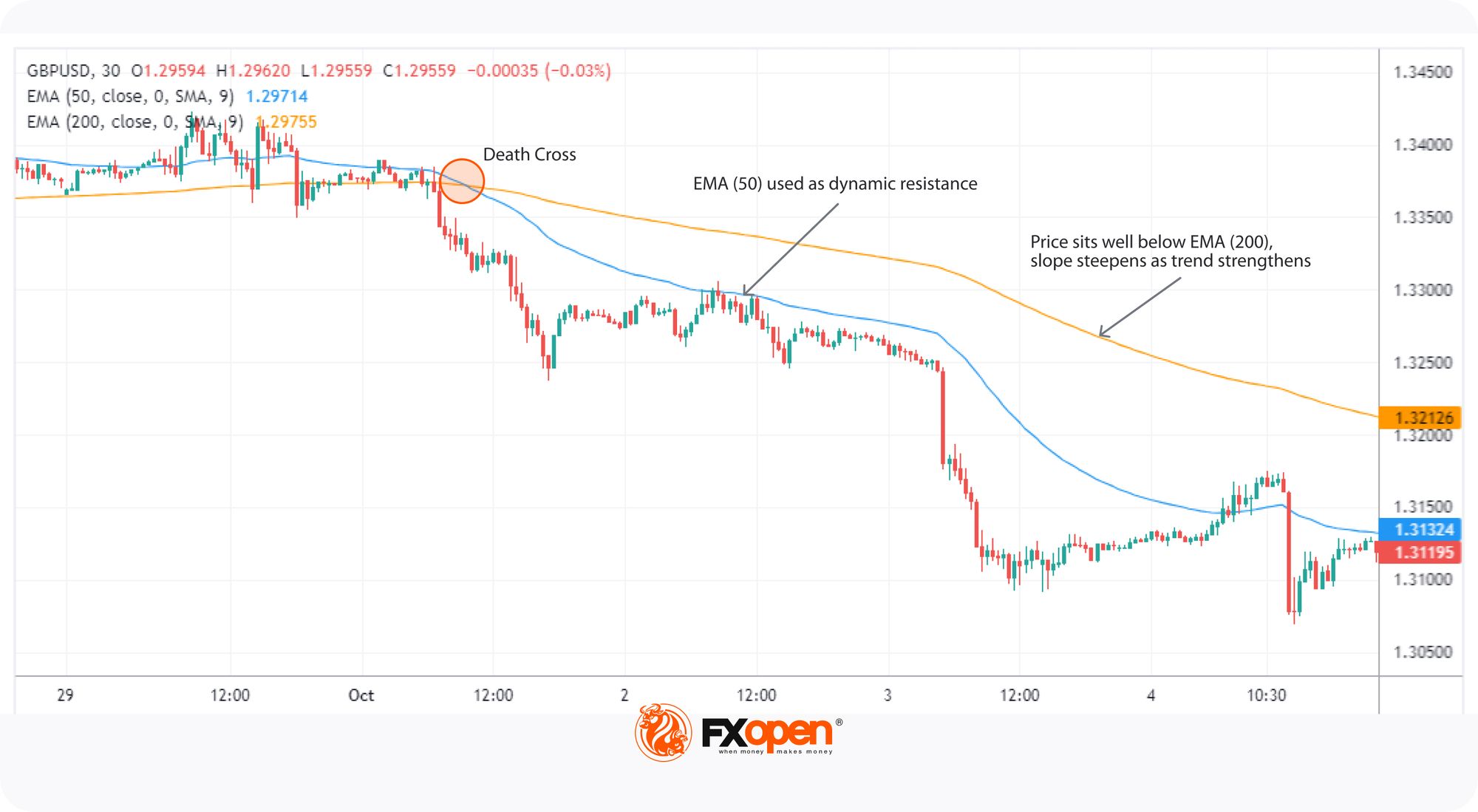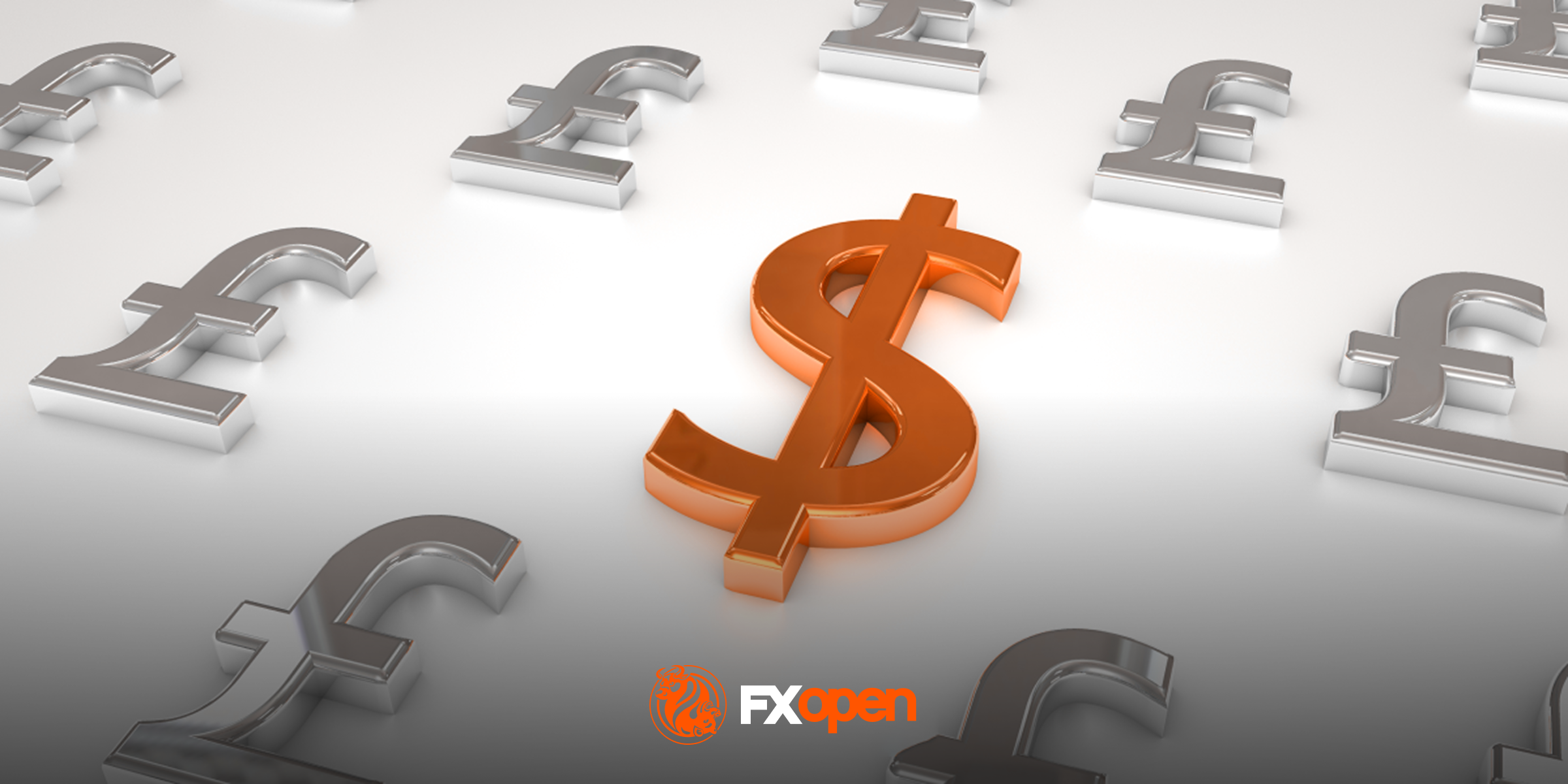FXOpen

Lagging indicators are fundamental tools in technical analysis, helping traders confirm trends and assess market momentum using historical price data. This article explores what lagging indicators are, the types available, and how traders use them in their strategies. We’ll also discuss their limitations and common mistakes traders should avoid.
What Are Lagging Indicators?
Lagging technical indicators are tools that traders use to confirm the direction of a price trend after it has already begun. There are leading and lagging technical indicators. The difference between leading and lagging indicators is that the former signal future price movements while the latter relying on past data help traders spot well-established trends.
These indicators work by smoothing out price movements over time, which helps traders analyse whether a trend is likely to continue. For example, after a market has been rising steadily, a lagging indicator may show that the trend has solidified, giving traders more confidence in their analysis. However, because they react to past movements, lagging indicators can be slow to signal when a trend is reversing, which is why they’re often used alongside other tools.
A lagging indicator is particularly useful in trending markets, where it can help confirm the strength and direction of price action. They aren’t as effective in sideways or range-bound markets because they lag behind real-time movements. Still, when used correctly, they can offer traders valuable insight into the market’s overall momentum and help filter out noise from short-term fluctuations.
Types of Lagging Indicators
Lagging indicators come in a few main types, each offering a unique way to analyse market trends.
These include trend-following indicators, such as moving averages, which smooth out price data to highlight the overall market direction. There are also volatility-based indicators, like Bollinger Bands, which assess the market’s fluctuations to identify possible turning points.
Additionally, momentum indicators, such as the MACD, track the speed of price changes to provide insight into the strength of a trend. Each class of indicator serves a specific purpose, giving traders different angles for analysing market movements based on past price data.
Note that lagging indicators in technical analysis are distinct from lagging economic indicators. The former uses historical price data to offer insights into future market movements, while the latter reflects past economic performance, providing a backwards-looking view of trends like unemployment, inflation, or GDP growth, which confirm the state of the economy only after changes have already taken place.
Below, we’ll explore four examples of key lagging indicators. To see these indicators in action, try them out on FXOpen’s free TickTrader trading platform.
Moving Averages

Moving averages are among the most widely used tools in technical analysis, helping traders smooth out price data to better identify market trends. There are many types of moving averages, but most traders use two primary types: the Simple Moving Average (SMA) and the Exponential Moving Average (EMA). While both calculate averages over a set period, the EMA gives more weight to recent prices, making it more responsive to market changes compared to the SMA, which treats all price points equally.
One of the key signals moving averages produce is the crossover, also called the Golden Cross and Death Cross. A Golden Cross occurs when a shorter-term moving average, like the 50-period EMA, crosses above a longer-term moving average, such as the 200-period EMA, indicating potential upward momentum. On the other hand, a Death Cross happens when the 50-period EMA crosses below the 200-period EMA, signalling a possible bearish shift. These crossovers help traders identify potential trend reversals.
Moving averages can be utilised as dynamic support and resistance levels. In an uptrend, prices often bounce off a moving average, acting as support. In downtrends, the same moving average can act as resistance, preventing price rises.
Another signal is the angle of the moving average itself. A rising moving average suggests an uptrend and a falling one indicates a downtrend. Traders often interpret this alongside whether the price sits above or below the moving average.
Bollinger Bands
Bollinger Bands are a versatile tool in technical analysis, designed to measure market volatility and potential overbought or oversold conditions. Created by John Bollinger, the indicator consists of three lines: a middle band (typically a 20-period simple moving average), and two outer bands plotted at two standard deviations above and below the middle band. These bands dynamically adjust as volatility changes, making them useful in different market environments.
According to theory, buyers dominate the market when the price rises above the middle line, while a drop below this line signals sellers gaining control. The bands can often act as a dynamic support/resistance level. However, these aren’t stand-alone buy or sell signals and should be confirmed with other indicators, like the Relative Strength Index (RSI), to avoid false alarms.
Another common signal Bollinger Bands provide is overbought and oversold conditions. When prices exceed the upper band, the market might be overbought, indicating potential exhaustion of upward momentum. Conversely, a dip below the lower band may suggest the asset is oversold, potentially signalling a bounce or reversal.
Another important signal Bollinger Bands provide is the Bollinger Band squeeze. This occurs when the bands contract tightly around the price, indicating low volatility. Traders see this as a precursor to a potential breakout, though the direction of the move is unknown until confirmed by price action. Once volatility expands, traders can look for a breakout above or below the bands to gauge direction.
Moving Average Convergence Divergence (MACD)
The Moving Average Convergence Divergence (MACD) is a popular momentum indicator that helps traders identify changes in market trends. It includes three key components: the MACD line, the signal line, and the histogram.
The MACD line is calculated by subtracting the 26-period Exponential Moving Average (EMA) from the 12-period EMA, which provides insight into the relationship between short-term and long-term price movements. The signal line is a 9-period EMA of the MACD line, and the histogram shows the difference between the MACD and the signal line.
MACD generates two key signals. First is the signal line crossover, where traders watch for the MACD line to cross above the signal line, which is often seen as a potential bullish indicator. When the MACD crosses below the signal line, it could indicate bearish momentum. The second signal is the zero-line crossover. When the MACD line crosses above the zero line, it suggests a shift toward bullish momentum, while crossing below the zero line may indicate bearish momentum.
The MACD histogram helps traders visualise the strength of momentum. Histogram bars above the zero line indicate bullish momentum, while bars below the zero line signal bearish pressure. As the bars contract, it may signal a weakening trend and a potential reversal.
Another key feature of MACD is divergence. If the price moves in one direction but the MACD moves in the opposite direction, it may signal a potential trend reversal. For instance, when the price is making higher highs but the indicator is making lower highs, it could indicate that upward momentum is weakening.
Average Directional Index (ADX)
The Average Directional Index (ADX) measures the strength of a trend, regardless of whether it's moving up or down. Created by J. Welles Wilder, it helps traders assess whether the market is trending or moving sideways. The ADX line ranges from 0 to 100, where values below 20 suggest a weak or non-existent trend and values above 25 indicate a strong trend. The higher the reading, the stronger the trend, with anything above 50 signalling very strong market momentum.
The ADX doesn’t specify whether the trend is bullish or bearish—it only gauges strength. To determine the trend's direction, traders typically combine ADX with the Directional Movement Indicators (DMI), which include the +DI and -DI lines (in the image above, ADX is represented with the pink line, while +DI is blue and -DI is orange). When the +DI is above the -DI, the trend is likely upward, and when -DI is above +DI, the trend is likely downward.
Key signals include the 25 level: a reading above this suggests that a trend is gaining strength. As ADX rises, the trend intensifies, and when it falls, the trend may be weakening, though this doesn’t necessarily imply a reversal.
ADX is particularly useful for trend-following strategies, but it’s important to combine it with other indicators for confirmation, as it doesn’t determine market direction.
How Traders Use Lagging Indicators
Traders use lagging indicators to confirm trends and evaluate the strength of market movements based on historical data. Here are several common ways traders apply these tools:
- Trend Confirmation: Lagging indicators help verify whether a price trend is well-established. For example, moving averages smooth out price data to confirm whether the market is in an uptrend or downtrend. Traders use these indicators to avoid reacting to short-term volatility and focus on longer-term trends.
- Measuring Trend Strength: Indicators like the Average Directional Index (ADX) and Bollinger Bands are used to assess how strong a trend is. A rising ADX signals increasing momentum, while Bollinger Bands widening can indicate higher volatility, suggesting the trend might persist.
- Spotting Momentum Shifts: Lagging indicators such as the Moving Average Convergence Divergence (MACD) or moving average crossovers can highlight shifts in momentum. For instance, when the MACD line crosses the signal line, it suggests a change in momentum, which could signal the continuation or reversal of a trend.
- Filtering Noise: Lagging indicators help traders filter out short-term market noise. By focusing on longer periods, like a 200-period moving average, traders can avoid being misled by temporary price fluctuations, ensuring they base decisions on potentially more stable trends.
Drawbacks and Common Mistakes with Lagging Indicators
While lagging indicators can be helpful, they come with limitations that traders should be aware of.
- Delayed Signals: Lagging indicators rely on historical data, which means they often confirm trends after they’ve already started. This delay can cause traders to enter or exit positions too late, missing a significant portion of the move.
- False Confidence in Trending Markets: Traders might over-rely on lagging indicators during sideways or choppy markets, leading to misleading signals. For example, the MACD might generate false crossovers, causing unnecessary trades in non-trending environments.
- Overuse Without Confirmation: A common mistake is using a single lagging indicator without additional tools for confirmation. This can result in trades based solely on outdated data, ignoring real-time market shifts. Combining lagging indicators with leading ones, like the RSI, can help avoid this trap.
The Bottom Line
Lagging indicators are valuable tools for confirming trends and helping traders make informed decisions based on historical data. While they have their limitations, such as delayed signals, they remain essential for understanding market momentum. Ready to apply these insights to more than 700 live markets? Open an FXOpen account today and start trading on four advanced trading platforms with low costs and rapid execution speeds.
FAQ
What Is a Lagging Indicator?
The lagging indicators definition refers to a tool used in technical analysis that confirms trends based on historical price data. It provides insight into the strength and direction of trends after they’ve already started, helping traders to confirm the momentum. Such indicators are moving averages and the Average Directional Index (ADX).
What Are Forward (Leading) vs Lagging Indicators?
Forward (leading) indicators attempt to determine future market movements while lagging indicators confirm past trends. Forward indicators, like the stochastic oscillator, signal potential price changes, while lagging indicators, like moving averages, confirm established trends.
This article represents the opinion of the Companies operating under the FXOpen brand only. It is not to be construed as an offer, solicitation, or recommendation with respect to products and services provided by the Companies operating under the FXOpen brand, nor is it to be considered financial advice.
Stay ahead of the market!
Subscribe now to our mailing list and receive the latest market news and insights delivered directly to your inbox.








